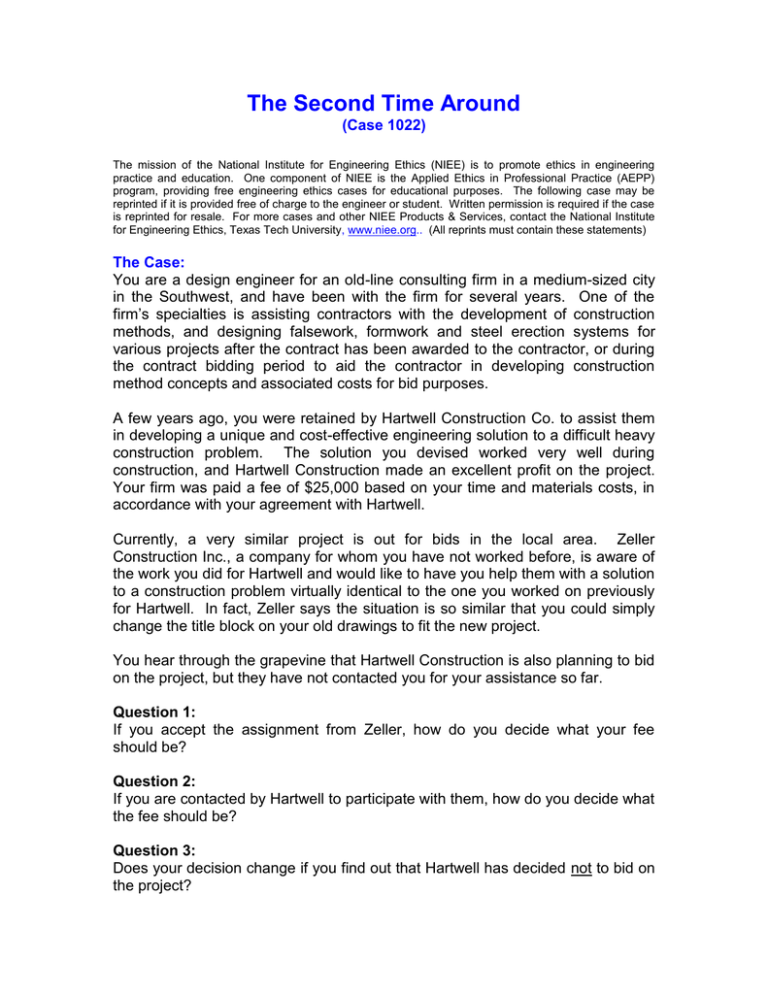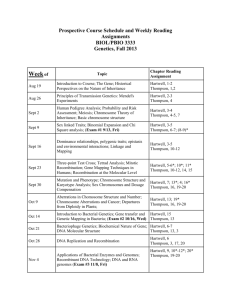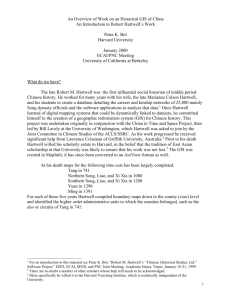The Second Time Around (Case 1022)
advertisement

The Second Time Around (Case 1022) The mission of the National Institute for Engineering Ethics (NIEE) is to promote ethics in engineering practice and education. One component of NIEE is the Applied Ethics in Professional Practice (AEPP) program, providing free engineering ethics cases for educational purposes. The following case may be reprinted if it is provided free of charge to the engineer or student. Written permission is required if the case is reprinted for resale. For more cases and other NIEE Products & Services, contact the National Institute for Engineering Ethics, Texas Tech University, www.niee.org.. (All reprints must contain these statements) The Case: You are a design engineer for an old-line consulting firm in a medium-sized city in the Southwest, and have been with the firm for several years. One of the firm’s specialties is assisting contractors with the development of construction methods, and designing falsework, formwork and steel erection systems for various projects after the contract has been awarded to the contractor, or during the contract bidding period to aid the contractor in developing construction method concepts and associated costs for bid purposes. A few years ago, you were retained by Hartwell Construction Co. to assist them in developing a unique and cost-effective engineering solution to a difficult heavy construction problem. The solution you devised worked very well during construction, and Hartwell Construction made an excellent profit on the project. Your firm was paid a fee of $25,000 based on your time and materials costs, in accordance with your agreement with Hartwell. Currently, a very similar project is out for bids in the local area. Zeller Construction Inc., a company for whom you have not worked before, is aware of the work you did for Hartwell and would like to have you help them with a solution to a construction problem virtually identical to the one you worked on previously for Hartwell. In fact, Zeller says the situation is so similar that you could simply change the title block on your old drawings to fit the new project. You hear through the grapevine that Hartwell Construction is also planning to bid on the project, but they have not contacted you for your assistance so far. Question 1: If you accept the assignment from Zeller, how do you decide what your fee should be? Question 2: If you are contacted by Hartwell to participate with them, how do you decide what the fee should be? Question 3: Does your decision change if you find out that Hartwell has decided not to bid on the project? Alternate Approaches and Survey Results for “The Second Time Around” (Case 1022) Question 1: 1. Since the construction problem is virtually identical to the one you solved for Hartwell, change the title block on the drawings to reflect the new project, as Zeller suggested, send them to Zeller and charge them a lump sum fee of $10,000. Percentage of votes agreeing: 2% 2. Since the construction problem is virtually identical to the one you solved for Hartwell, change the title block on the drawings to reflect the new project, as Zeller suggested, send them to Zeller and charge them a lump sum fee of $15,000. Percentage of votes agreeing: 2% 3. Since the construction problem is virtually identical to the one you solved for Hartwell, change the title block on the drawings to reflect the new project, as Zeller suggested, send them to Zeller and charge them a lump sum fee of $25,000. Percentage of votes agreeing: 19% 4. While no construction problem is identical to one encountered on a different project, you put enough effort into the original solution that there can’t be a whole lot of additional effort involved in this assignment. Tell Zeller you will work for them for a lump sum price (which includes your best estimate of the additional time involved for this project plus a fixed figure for use of the methods developed for the original project) of $15,000. Percentage of votes agreeing: 20% 5. No construction problem is actually identical to that encountered on a different project. Offer to review your original calculations based on the details of the new project and provide job-specific drawings and calculations to Zeller for a fee based on the time involved in adjusting/updating the drawings and calculations. Percentage of votes agreeing: 57% Question 2: 6. Since the construction problem is virtually identical to the one you solved before for Hartwell, change the title block on the drawings to reflect the new project, send them to Hartwell and charge them a lump sum fee of $10,000. Percentage of votes agreeing: 4% 7. Since the construction problem is virtually identical to the one you solved before for Hartwell, change the title block on the drawings to reflect the new project, send them to Hartwell and charge them a lump sum fee of $15,000. Percentage of votes agreeing: 3% 8. Since the construction problem is virtually identical to the one you solved before for Hartwell, change the title block on the drawings to reflect the new project, send them to Hartwell and charge them a lump sum fee of $25,000. Percentage of votes agreeing: 11% 9. While no construction problem is identical to one encountered on a different project, you put enough effort into the original solution that there can’t be a whole lot of additional effort involved in this assignment. Tell Hartwell you will work for them for a lump sum price (which includes your best estimate of the additional time involved for this project plus a fixed figure for use of the methods developed for the original project) of $15,000. Percentage of votes agreeing: 22% 10. No construction problem is actually identical to that encountered on a different project. Offer to review your original calculations based on the details of the new project and provide job-specific drawings and calculations to Hartwell for a fee based on the time involved in adjusting/updating the drawings and calculations. Percentage of votes agreeing: 60% Question 3: 11. Yes, if you have decided to charge a lump sum to Zeller, increase it. Percentage of votes agreeing: 11% 12. No, stay with your decision for your work with Zeller as you indicated under Question 1, above. Percentage of votes agreeing: 89% Forum Comments from Respondents 1. First come, first served in business. I am a contracted employee, and nothing is ever the same, especially when it comes to dealing with construction. 2. For Question 1: Zeller is looking for the cheap engineering solution. From past history, most situations in the engineering and construction arena are not “so similar”. Maybe your quote (budget estimate?) should be on a T&M (Time and Materials) basis. If the project is similar to the previous one, the engineering fee should end up being less. If not, you are compensated fairly for the design. Under no conditions should Lump Sum be considered until you fully understand the entire scope of the project. Varying loads and how they are applied could result in a completely new design. New details may be required and take time to develop. 3. For Question 2: You could give Hartwell the same quote (budget estimate?) given to Zeller. At this point the contractors are looking at you as a subcontractor who has no allegiance to either of them and quoting both should not be considered unethical provided the same fee arrangements are quoted to both. You are not working for either of them yet and there is no other firm quoting fees to provide the same services. Nonetheless, this approach might backfire because one or both of them might not think of you as a “team player”. Either way, the quote to Zeller should not change if Hartwell decides not to bid the project. 4. You should consider applying for a US and an international patent for the original design you developed for Hartwell and offer to make the design available to Zeller at a fee you expect will cover the costs of applying for and acquiring the patents. 5. Additional information about the original contract between your firm and Hartwell would be helpful. If Hartwell retained ownership of the design as part of your contract with them, then you should decline working for Zeller Construction. On the other hand, if your firm retained ownership of the original documents, then you are free to enter into an agreement with Zeller, since the obligation to Hartwell was fulfilled on the first project. As a matter of courtesy, however, you should notify Hartwell that you are planning to be a subconsultant to Zeller. 6. The fee charge Zeller should be based on the value of the services you will be providing, and not on a time and materials basis. The fee should be in the range of the fee charged to Hartwell for the original work.






